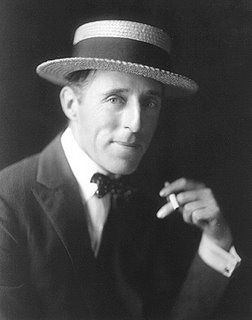Writing History with Lightning

"(H)e was a great primitive poet, a man capable, as only great and primitive artists can be, of intuitively perceiving and perfecting the tremendous magical images that underlie the memory and imagination of entire peoples." -- James Agee.
The man who was most responsible for turning the cinema into an effective storytelling art form was born on this day in 1875 on a farm in Kentucky to a former Confederate cavalryman. D.W. Griffith's Southern beginnings were to mold his films throughout his career, producing his love for rural life, the sweet chivalric traditions of the antebellum South, and his naive political assumptions.
By the age of 21, he was hanging around the theater, "carrying a spear" in a Sarah Bernhardt production which blew through Louisville and playing melodramas in undistinguished traveling stock companies. He left the theater in 1906, moved to New York and began to pursue a writing career, imagining that he was destined for great things but having no idea how he would realize his promise.
Although one of his plays was optioned at the end of 1906, he was still just an unemployed actor when he started working for the Edison Film Company in New York for $5 a day, starring in a couple of films by the most important American filmmaker before Griffith, Edwin S. Porter. In 1908, he moved to Edison's chief rival, the Biograph Company, where he wrote and acted in incoherent films made by a hapless hack named Wallace McCutcheon, son of Biograph's retiring principal director Old Man McCutcheon. Soon Biograph pressed Griffith into service as a director, and Biograph as well as the film medium itself began to be transformed by his work. Directing more than 420 one and two-reel films from 1908 to 1913, he did not invent such devices as the close-up, special lighting effects, cross-cutting and panoramic views, but he managed to turn them in his hands to create film-stories with a level of narrative complexity, thematic subtlety and stylistic fluidity not previously experienced by nickelodeon audiences. Screening a few dozen of these films at one sitting gives one the sense of an artist experimenting with discarded odds and ends and emerging with a powerful vocabulary of film storytelling.
Even before he made his first feature-length films, he had directed a number of enduring classics (including The Lonely Villa (1909), the forerunner of every "woman alone in the house" suspense thriller; A Corner in Wheat (1909), an anti-big business melodrama whose climax was pilfered by Peter Weir in Witness 76 years later; and The Musketeers of Pig Alley (1912), a forerunner of the James Cagney/Edward G. Robinson-type gangster movie), and had established a solid company of technicians and performers who would go on to make their mark in the world of cinema (cameramen Billy Bitzer and Karl Brown; future directors Mack Sennett, Raoul Walsh and Erich von Stroheim; and actors Lillian and Dorothy Gish, Mary Pickford, Lionel Barrymore, Robert Harron, Henry B. Walthall and Mae Marsh, to name but a few).
As his short films began to grow larger, he moved from Biograph to the Mutual Film Company in 1913 and consolidated his relocation to southern California and began making longer films. Griffith's The Birth of a Nation (1915, based on Thomas Dixon's novel, The Clansman, about the Ku Klux Klan) signaled the potential of cinema in no uncertain terms. Southern-born Woodrow Wilson said it was like "writing history with lightning," but although Griffith softened the luridly racist material on which it was based, the film provoked massive protests, led by NAACP leader W.E.B. DuBois -- the first of their kind against a mere movie in America. Griffith had created a work of art of such power that it became central to American social and political discourse, and cinema would never be the same afterward.
Griffith continued to make major silent films, some artistically successful (including Broken Blossoms, 1919, with Lillian Gish and Richard Barthelmess; Way Down East, 1920, again with Gish and Barthelmess; and Orphans of the Storm, 1922, with the Gish sisters), some were ambitious but flawed (the dizzyingly multi-plotted Intolerance, 1916; and Isn't Life Wonderful, 1924, starring his sadly inept Galatea, Carol Dempster), but eventually his work faded into obscurity and irrelevance.
By the end of the silent era, he was regarded as something of a living dinosaur. He made two talking pictures before retirement was imposed on him. In later years, he twiddled at unfinished projects, drank excessively, emerged to serve as "advisor" to Hal Roach's One Million B.C. (1940) (prompting inside jokes around Hollywood about the unearthing of the "pre-historic" director), and died alone, though not completely penniless, in a Hollywood hotel room.
Labels: Silent Film





4 Comments:
You beat me to the punch, or post, rather, again. Oh well, I'll catch his death day.
Thanks for this- it's great to see the immortals noted once and a while.
Always happy to oblige.
Nice post. From the various writings I've read from Griffith's actresses, I'm always amazed how much they are in awe of him. Lillian Gish, Mae Marsh, and Miriam Cooper all seem to idolize his vision and methods, portraying him as a great artist where the later producers and directors were driven by money. Miriam Cooper noted how Griffith seemed to only sign actresses who had grown up without fathers and he inserted himself in that role. That's a slighty disturbing way to build a movie company.
Indeed -- could get you arrested today!
Post a Comment
Subscribe to Post Comments [Atom]
<< Home